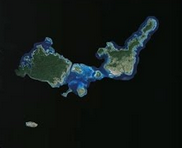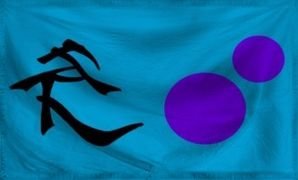You know, sometimes the best way to run a country is to let a 4-year-old girl be the prime minister as the attorney general awaits the national creed while wrapped up in purple linen.
Today we're going to cover the only danish speaking country in the indian ocean.

But first, you know the drill, let's dissect the flag. The flag of bandiaterra is one of the only two sovereign nation flags in the world that has the color purple on it.

The other one being dominica with its cute little sisserou bird. The flag has two purple circles on it on the right side to indicate the two main islands on the country, bandia and terra.
The purple color represents the field of the iconic tropical lavender that the island is rich in. The blue field represents the indian ocean that surrounds the islands. On the hoist side on the left we have the word bandia written in the tribal bandia script, one of the only indigenous african scripts to have survived and is still in use today.
But we're nowhere near africa for this country. Let's find out where it is in. Bandiaterra's location is actually pretty cool, it's located in the central indian ocean just southeast of the british indian ocean territory islands, and halfway between them and the cocos or keelings islands.
The country is made up of eleven islands only five of which are inhabited. 2 of which maintain global affairs and modern societies the largest islands, bandia and terra, slightly larger than the size of puerto rico, with 3 smaller incorporated autonomous island territories.
The 1rst island of these 3 is vyaja, the 2nd one, although a little northeast, is terraya. And finally, we reach the smallest one tavarana with only 47 people yup, only under 48 living lives fit on really intense terrain.
These 3 islands are almost completely cut off from the other islands, but still maintain sovereignty agreements so that bandiaterra can kind of rule over them, but loosely, it's weird.
The capital is Øtnæuetrę, located on bandia, and is suprisingly a fast-growing city that is really starting to invest in its architectural endeavours in the 1980's, bandiaterra only had rudementary buildings and residential units until offshore oil was discovered.
And since then, bandiaterra has seen its first apartment complexes and high-rise commercial buildings sprout up all over the capital. The country doesn't stop at oil, though.
It's actually investing really heavily in its tourism sector and capitalizing on various sites unseen anywhere else on earth. Sites we will discuss in: (earthquake rumbling) (bird caws) now, bandiaterra's landscape is almost incomparable to anywhere else on earth.
As a volanic archipelago, much like hawaii, the area has fascinating isolated structures that give it an almost creepily-beautiful appeal. For one, bandiaterra is one of the only few places in the world that has black sand beaches, attirbuted to the volanic soil and erroded rocks.
This makes up a huge tourist spot that the island banks off of for economic revenue. Now, with a growing population but with limited land area, bandiaterra has actually done something really cool and smart.
They've actually utilized underwater space on their corral reefs and beaches for aquatic crop production. To this day, bandiaterra grows and harvests some of the world's finest kelp, kolmbu, dolce, and laver.
The crops also make up a huge part of the typical bandiaterran diet. Agriculture employs about 22% of the population. But what really sets bandiaterra apart would have to be their enormous fields of rare bandiaterran lavender, which is the southermost gorwing version of the plant species on earth with a richer potency than its northern cousins, used for oil extracts, nectars, and so on.
Bandiaterran lavender was and still is one of the most highly prized exports of this region. In fact, the queen of denmark even said something about it. Queen caroline matilda, wife of king christian the 7th of denmark, is quoted for saying: " my petunias, my daffodils, from whenceforth they shall arrive, " " but the pristine magnificence of a true bandi blossom must always be pure in its origin of the south seas." another cool thing is that bandiaterra is known for having some of the coolest glow worm caves in the world.
These caves actually light up upon noise, and the first inhabitants of the islands, upon discovery, referred to these caves as the " star caves." but who are the real stars of bandiaterra? Let's find out in: (conch shell horn) throughout all of human history, bandiaterra is a true sociological gem, and the reason is because it's one of the only few african conquest nations in which bantu peoples from the eastern side of africa, of what are now known as tanzania and kenya, came over to the island and inhabitated it.
The people who left were primarily intellectual africans from the bandia tribe, who had learned european-style boat construction and sailing techniques from the portugese just around the time of the omani sultanate as they were instituting the arab slave trade.
Now, in an attempt to escape the much fiercer and tortorous omanis, they embarked on a mass exitos to pretty much anywhere. They didn't quite frankly know where they're going, they just didn't like the salt in it.
After months of stopping along ports and seychelles and maldives, they finally discovered and landed upon 2 main islands, which they aptly named bandia and terra. The portugese word for " land".
To this day, the islanders are predominately african in their ethnic origin, however, the majority of bandia pilgrims were biracially mixed with portugese blood and were distinguishably lighter in their complexion than the other tribes.
Which explains why they were such outcasts from the rest of the bantu tribes, as they were seen as white-man-loving people. Nonetheless, the population is about 79% afro-bandian, 18% white, mostly danish, and the remaining 3% being south indian and bengali.

But, why danish? Well, as it turns out soon after the bandi had discovered the islands and developed a relatively stable society for decades, the danes bumped into the islands and were suprised to find portugese-speaking africans.
Famous danish explorer jørgen jørgensen was on his way to australia when he and his crew found bandiaterra. Afterwards, he immediately reported his findings to king frederick vi, and over the next century, tons of danes flocked to bandiaterra and eventually reshaped the entire cultural dynamic to this day.
In fact, danish is actually a secondary language to these people, and they've even adopted the danish alphabet as a secondary script in addition to the bandian script, which is an ancient syllablery of over 80 different characters and 10 different accent marks written up and down.
Some have even mistaken bandian for chinese or the traditional mongol script. However, the weirdest part about bandiaterra would have to be its parliament and its 3 autonomous islands. For one, the 3 islands are inhabited by the sana bandias, a subtribal group that has decided to live independently with a more rustic, conventional lifestyle free of modern technology.
They still allow bandiaterra to kind of " have sovereignty" over them and do business. However, they are social security and tax exempt.
And by all means, operate in their own self-rule. You could kinda kinda take the sana bandia people as kind of like the " amish" of the country.
Now, the bandiaterra government is kinda strange in that they elect officials to rule for 9 months out of the year, but then for 3 months, a technical " monarch" overrides parliament and has the final say.
What's even stranger is that every year, on july 31st, or children's day, parliament is required by law to put the youngest child of the monarch to act as prime minister.
Whereas the prime minister assumes the position of attorney general for the day, as he or she is bound up by purple lavender dyed velvet drapes and they recite the national creed to symbolize the escape from the arab slave trade and the prosperity of the country.
Speaking of things people try to escape from: bandiaterra is quite the unique marble in that for many years after its discovery and development, it was virtually unknown to any outsiders.
They first came into contact with sri lankans and developed trade partnerships with them. However, things didn't really kick off until the 19th century, when the danes came in and introduced ideas and concepts that completely revolutionized the nation.
Priot to the 19th century, the country was kind of frozen in a 15th century techonological era, whereas the rest of the world was going through the industrial revolution.
Bandiaterra also gets along suprisingly well with singapore and australia. The 2 countries have been tied together for over a century with diplomatic missions and policy developments, and the australians were also the largest aid supporters during cyclone nadine back in 1977.
However, the best friend of the country would have to be the danes, from denmark. Danes were welcomed since day 1, and eventually they became close partners in trade and diplomacy.
Interestingly enough, the danes were actually not that interested in colonizing bandiaterra for themselves. But rather, they say it as a great place to invest in for a prosperous exchange.
Plus, most of the danish immigrants were christian missionaries who built the country's first hospitals, modern day universities and needless to say, the bandians quickly embraced a danish lifestyle and culture.
How u say like this ? mnossen